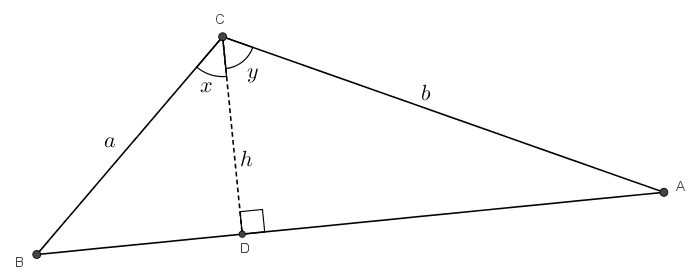On considère deux angles non nuls \(x\) et \(y\) tels que \[0< x + y<\pi\]

\[(\text{Aire du } \triangle ABC) = (\text{Aire du } \triangle BCD) + (\text{Aire du } \triangle ACD)\]
En utilisant la formule trigonométrique de l’aire du triangle, on obtient \[\tfrac{1}{2} a b \sin\left(x+y\right) = \tfrac{1}{2}a h\sin\left(x\right) + \tfrac{1}{2} b h \sin\left(y\right)\]
Dans le triangle \(BCD\), on a aussi \[\cos(x) = \frac{h}{a}\]ou \[h = a \cos(x)\]Dans le triangle \(ACD\), on a \[\cos(y) = \frac{h}{b}\]ou \[h = b \cos(y)\]
L’astuce est de remplacer \(h\) dans\[\tfrac{1}{2} a b\sin\left(x+y\right) = \tfrac{1}{2}a h\sin\left(x\right) + \tfrac{1}{2} b h \sin\left(y\right)\]tantôt par \(b \cos(y)\), tantôt par \(a \cos(x)\).
\begin{align*}\tfrac{1}{2} a b \sin\left(x+y\right) &= \tfrac{1}{2}a b \cos(y) \sin\left(x\right) + \tfrac{1}{2} b a \cos(x) \sin\left(y\right) \\ \\ &=\tfrac{1}{2}ab\left(\sin(x)\cos(y) + \sin(y)\cos(x)\right) \end{align*}
Il ne reste qu’à diviser les deux côtés par \(\frac{1}{2} ab\) pour obtenir \[\sin(x+y) = \sin(x)\cos(y) + \sin(y)\cos(x)\]